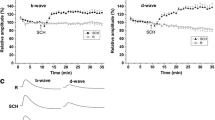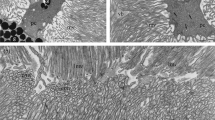Abstract
The implication of dopamine in the modulation of the standing potential of the eye was tested in the chicken through an indirect electrooculographic method and direct current electroretinogram (ERG) recording after haloperidol, a mixed D1-D2 antagonist. The standing potential of the eye was reduced within 15 min after intravitreal injection of the antagonist (150 μg). This effect is rapidly reversed by an application of dopamine. The fast oscillation was preserved but the light peak was either strongly reduced or abolished. The dark trough showed an apparently normal time course. The intensity-voltage function was studied for the various ERG components. After haloperidol the b-wave and the c-wave were strongly reduced, whereas the a-wave was little affected. Together with previous data obtained with intraocular injections of dopamine, our data suggest the involvement of dopamine in the modulation of the standing potential. They also support the hypothesis that the light peak, which is generated by a photoreceptor-pigment epithelium interaction, is influenced by dopamine or by a related substance. The modulatory effect could also be due to a balance between several neurotransmitter systems.
Similar content being viewed by others
References
Dawis N. Niemeyer G. Dopamine influences the light peak in the perfused mammalian eye. Invest Ophthalmol Vis Sci 1986; 3: 109–18.
Rudolf G, Wioland N, Kempf E, Bonaventure N. Electrooculographic study in the chicken after treatment with the neurotoxin 6-hydroxydopamine. Doc Ophthalmol 1989; 72: 83–91.
Nguyen-Legros J, Verseaux-Botteri C, Vigny A, Roux N. Tyrosine hydroxylase immunohistochemistry fails to demonstrate dopaminergic interplexiform cells in the turtle retina. Brain Res 1985; 339: 323–8.
Brainard GC, Morgan WW. Light-induced stimulation of retinal dopamine: a dose-response relationship. Brain Res 1987; 424: 199–203.
Rudolf G, Wioland N, Kempf E, Bonaventure N. EOG and ERG modifications induced in the chicken after blockade of catecholamine and 5-HT biosynthesis. Doc Ophthalmol 1990; in press.
Wioland N, Bonaventure N. Photopic c-wave in the chicken ERG: sensitivity to sodium azide, epinephrine, sodium iodate, barbiturates and other general anesthetics. Doc Ophthalmol Proc Series 1985; 60: 407–12.
Sato T, Yonemura T, Kim HK, Suzuki TA. Effect of dopamine and haloperidol on the c-wave and the light peak of light-induced retinal responses in chick eye. Doc Ophthalmol Proc Series 1987; 67: 87–96.
Bruinink A, Dawis S, Niemeyer G, Lichtensteiger W. Catecholaminergic binding sites in cat retina pigment epithelium and choroid. Exp Eye Res 1986; 63: 147–51.
Dowling JE. Dopamine: a retinal neuromodulator? Trends Neurosci 1986; 9: 236–40.
Teranishi T, Negishi K, Kato S. Dopamine modulates potential amplitude and dye coupling between external horizontal cells in carp retina. Nature 1983; 301: 243–6.
Dearry A, Burnside B. Regulation of cell motility in teleost retinal photoreceptors and pigment epithelium by dopaminergic D2 receptors. In Redburn DA, Pesantes-Morales H, eds. Extracellular and Intracellular Messengers in the Vertebrate Retina. New York: Alan R. Liss, 1989; 229–56.
Author information
Authors and Affiliations
Rights and permissions
About this article
Cite this article
Wioland, N., Rudolf, G. & Bonaventure, N. Electrooculographic and electroretinographic study in the chicken after dopamine and haloperidol. Doc Ophthalmol 75, 175–180 (1990). https://doi.org/10.1007/BF00146553
Accepted:
Issue Date:
DOI: https://doi.org/10.1007/BF00146553




